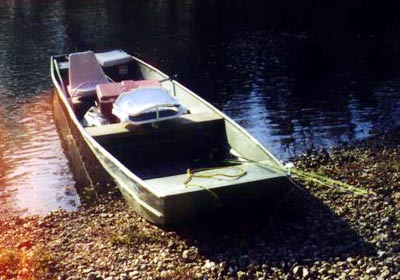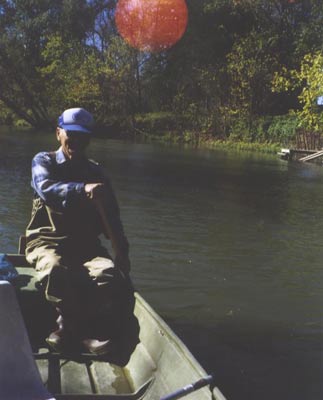Boat Advice
A Letter from:
by Jim Hauer
Chuck,
You might recall some correspondence we had and the write
up I did for Duckworks on the two Jonsboats
I built last winter.
I would like to ask for your help
on a new project I have been working on.
Investigating Jon boat designs,
I was fascinated with the different designs developed, particularly
those used in Missouri and Arkansas Ozark Mountain rivers. I discovered
that in the old days there were three principle designs or styles
of Jons in use in that area; the White River, Current River and
the Big Piney River styles. Early on, these boats were somewhat
crudely built from rough local unplaned lumber. They were very
heavy and difficult to transport over land. Many of these jonboats
were built in the 1900's up to the '50's and were used by area
resorts and individual fishing guides. An unusual characteristic
of all three of the designs was that they were either paddled
or poled, not rowed. I was astonished and couldn't imagine anyone
being able to paddle any kind of "jonboat". Of course,
I was thinking of a jonboat as a wide, flat-bottomed craft like
the Jonsboats or the aluminum ones widely sold today.

One can still see White River
jons in use for guiding fishermen on the White and Norfork Rivers
tailwaters below Bull Shoals and Mountain Home, Arkansas. A few
small local boat companies make an updated fiberglass version
of the White River style. Probably the best of these are the ones
made and sold by Supreme Boat Mfg. located in Flippin, AR. Their
jonboats are 20' 6" in length, fairly narrow beam and low
sides. They are usually powered by an outboard motor, often a
jet, to run the river.
The Current River style has all
but disappeared. I know of no boats in use or on display anywhere
representing this design.
The Big Piney River style has survived
in a limited way. Fred Dablemont of Houston, Missouri developed
the original design on the banks of the Big Piney River in the
early 1900’s. His son Farrell later popularized the design
and built and sold the boats in wood. Norten, another of Fred's
sons, used the boats for a lifetime as a fishing guide. Lowe Boat
Mfg. of Lebanon approached Fred and Farrell in the '50's and obtained
permission to use their dimensions and design to manufacture the
boat in aluminum. They developed and sold their aluminum version
through the '70's as Lowe's "Paddle Jon". The boat was
available in both a 15ft. and 17ft. version. Lowe Boats discontinued
the design after OMC Corporation bought them out. Lowe/OMC did
make some small runs of the boat production for a few resorts
in the '80's but did not even advertise the boat in its regular
sales literature. Later, Generation Three Boat Company, founded
by one of the former owners of Lowe, and also in Lebanon, made
a small number of the same Paddle Jons. They were discontinued
too after that company was bought out by Yamaha Motors and operates
today as G3 Boat Manufacturing, still located in Lebanon.

Over the past year, I have corresponded
with outdoor writer Larry Dablemont, Farrell's son and grandson
of Fred. Farrell actually built an "Authentic American Jonboat"
on-site at Silver Dollar City near Branson last year as part of
the exposition's celebration of local crafts and arts. Three weeks
ago, on vacation to Missouri I arranged to take a float and fishing
trip in one of the original aluminum 18ft. Paddle Jons guided
and paddled by Norten Dablemont. Norten last week celebrated his
80th birthday. What an enjoyable trip while Norten paddled the
jon boat covering seven miles of the Ninangua River. I was amazed
at the control of the boat Norten had using just a paddle from
the stern. He could run rapids and even paddle upstream against
the current. Norten demonstrated both to me. Of course, he has
had lots of practice. He told me that he has been doing this since
he was nine years old. Also, when you hang on a shoal it’s
a simple matter to shift weight toward the bow to slide off. After
the trip, Norten gave me an autographed copy of his book "Ridgerunner",
an autobiography of his colorful life as an Ozark Mountain fishing
guide and paratrooper survivor of the Battle of the Bulge in WWII.
Now I am trying to find a way
to construct a replica Paddle Jon from plywood. I am thinking
that probably I would build the 15 footer. I have been able to
obtain some scarce literature about the aluminum version. At least
I have a description, some dimensions and some photos to go by.
However, I am not up to replicating the design features that boat
has and transferring them to a buildable design and blueprint
plan. I would hate to make a serious mistake. The design is not
complicated but there are always subtleties of any design that
can escape notice by one as inexperienced as I.
I hope that you will be able to
suggest someone who might be willing to help design a replica
of the Big Piney Paddle Jon to be built out of ply. I am attaching
a couple of photos of the boat.
Following is a brief description
by the Lowe Company: "Paddle Jon 15/17. The Paddle Jon, a
close replica of the original Jon boat, features a raked bow and
stern with shallow draft at the mid-ship. When you hang on a shoal,
it's a simple matter of shifting weight toward the bow to slide
off. The 15-foot model weighs only 93 pounds, the 17-foot only
110. Both are ideal for car-topping. A special marine aluminum
alloy provides less weight and the same strength and resistance
to puncture as though heavier gauge metal were used. A special
raised transom allows outboard motor operation in very shallow
water. Motor size ranges from a maximum of 5 horsepower on the
15-foot Paddle Jon to 10 horsepower on the longer boat. With the
semi-rocker bottom, boat control and paddle responses are quick
and sure. Its the kind of boat one person can handle with ease."
Dimensions |
15-foot |
17-foot |
| Length |
15' |
17' |
| Beam |
46 1/2" |
46 1/2" |
| Side depth |
14" |
14" |
| Seats |
3" |
4" |
| Weight |
93lbs |
110lbs |
| Hull gauge |
.051" |
.051" |
| Max weight cap. |
480lbs |
580lbs |
| Max. h.p. |
5hp |
10hp |
| Bottom keels |
4 |
4 |
| Bottom width |
32" |
32" |
| Transom width |
33" |
33" |
| Transom height |
16" |
16" |
My note: (note that transom height
includes the center mount motor board, which is higher than the
full width transom, visible in the photos)
I am looking forward to your reply.
Thanks.
Best,
Jim Hauer
|

